Proven Winners partners with private equity to consolidate ownership, expand capabilities
In the first big consolidation/private equity deal horticulture has seen in some time, the owners of Proven Winners—Tom and Sharon Smith of Four Star Greenhouses in Michigan and the Huntington Family of Pleasant View Gardens in New Hampshire—have sold a share of their greenhouse businesses and the Proven Winners plant brand to Staple Street Capital, a private equity firm out of New York. The partners say the new ownership structure will allow the company to “drive consumer demand, deliver greater simplicity and improve service for growers, retailers and consumers” in a way that operating as separate businesses never allowed.
Since founding the Proven Winners brand in 1992, the Smiths and Huntingtons have operated their greenhouses as two distinct businesses that control and operate the plant brand. (A third founder, EuroAmerican Propagators, left the partnership in 2017.)
Now, both greenhouses plus the plant brand will operate as one company under the name Proven Winners, with one ownership structure. Tom and the Huntingtons will remain as active owners and managers, while Staple Street Capital will provide additional resources, expertise and strategic support to strengthen the company’s position in the market while preserving its culture, values and legacy.
Who is Staple Street Capital, and why did they invest in Proven Winners? We spoke via Zoom with managing partner and chief investment officer Hootan Yaghoobzadeh, a Harvard MBA who co-founded the private equity firm in 2010. Hootan told us Staple Street is not a stranger to floriculture; their $900 million portfolio includes two green industry businesses: Delaware Valley Floral Group of Sewell, New Jersey, which distributes cut flowers and floral supplies in the Northeast and Mid-Atlantic regions; and Garden State Bulb of Vineyard, New Jersey, which distributes dry flower bulbs to 7,000 big box stores and IGCs.
“As consumers, we know the brand and love the brand, what it stands for and the quality of its product,” Hootan said of Proven Winners. “And then through our interactions with Garden State, which already licenses the Proven Winners brand for the consumer bulb market, we came to understand that it is three different businesses. From a business perspective, we wanted to know how these guys got so successful and created such an iconic brand in an industry where brands never existed.” He added that if Tom and the Huntingtons could do that while operating in separate and competing businesses, “Imagine what they could accomplish in a true partnership, working together as one team and one company, with one voice.”
Joked Tom Smith, who was also on the call along with Henry Huntington, “We always said we’re successful in spite of ourselves.”
The deal was more than two years in the works, but through the many discussions they found they shared the values and vision that could help the business grow. “We felt like this was a really good partnership that had all the ingredients for us to be successful,” said Hootan.

Proven Winners (continued)
We asked Tom and Henry why they decided to sell a share of their companies (the exact percentage of which they would not disclose). Both said it was to grow the business in a way they couldn’t when the two greenhouses were competing with one another.
“It prevented us from doing so many things,” explained Tom, “whether it was unifying products, tray sizes, distribution—there are so many opportunities that we could not do, couldn’t even talk about. We had to ship all this stuff out of our own greenhouses. We couldn’t open up any other new locations. Now we can actually have better distribution, better customer service, one voice. It’s just a no-brainer.”

Hanging baskets at Four Star Greenhouses.
Tom added that, while he has no family succession plan, “This [Four Star and Proven Winners] is my baby, and I want to make sure that the baby is headed in the right direction … I love our industry, I love what we’re doing … I’m having fun, and I’m really looking forward to the new fun I’m going to have. I definitely see the growth and opportunities that we have in front of us.”
For the Huntingtons, it was a big decision, Henry says, but one that secures the long-term future for his family and the employees.
“It’s not about bringing business together, consolidating and all that,” Henry said. “It’s really about growing this company. And that’s what Staple Street is all about. It is bringing us together using the best practices and pursuing excellence to take this to the next level.”
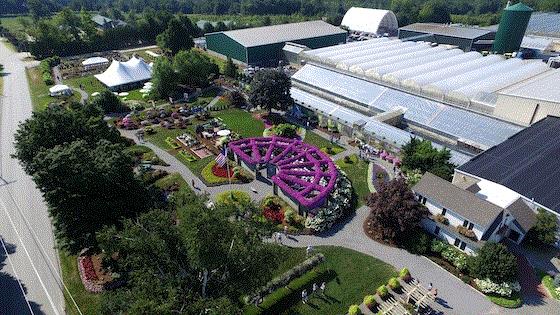
Summer open house at Pleasant View Gardens.
As for suppliers, customers and the consumer, day-to-day operations and customer relationships will remain unchanged in the near term. There’s also no change for Proven Winners’ brand license partners, which include Nordic Nurseries, Ed Sobkowich Greenhouses, Spring Meadow Nursery, Walters Gardens, Classic Caladiums, The Plant Company and Garden State Bulb.

Another Dutch grower in financial trouble
A few weeks ago, I told you about top-notch potted plant grower Bunnik Plants closing its doors, citing margin pressure, reduced demand, oversupply, higher costs for energy and sea transport, and tariffs. Now another big Dutch greenhouse, Schneider BV, aka Schneider Young Plants, is doing the same—except in Schneider’s case, declaring bankruptcy in hopes of keeping the business going.

Schneider's new 8.5-acre plug and liner production range in Woudrichem, which they moved into in 2021.
The announcement came on Monday, October 13, from the District Court of Breda in the Netherlands. Here is the full (but short) press release I found on Schneider’s website:
Bankruptcy of Schneider B.V. – discussions and search for restart in full progress
On Monday 13 October 2025, the District Court of Breda declared Schneider B.V., based in Woudrichem, bankrupt. This brings an end to the suspension of payment that had been in effect since 3 October. Mr. A.J. van der Knijff of Bron Advocaten has been appointed as curator.
Schneider B.V. has grown into a leading producer of young plants, working with partners in more than 30 countries. The company is known for its quality, reliability, and cooperation within the international ornamental horticulture sector.
The management and curator are currently exploring several restructuring and restart options.
Discussions with potential partners and investors are in full progress. The aim of this restart is to preserve the experienced team and the modern production site in Woudrichem, ensuring that the established position of Schneider in the international young plant market can continue.
Clarity is expected by the end of October, enabling a potential continuation in time for preparations for the 2026 cultivation season.

Schneider (continued)
Schneider offered no explanation for the drastic move, so I asked one of their competitors, Leo Hoodendoorn of young plant producer Florensis, what the market conditions are like in Europe that might lead to this.
“A lot is going on over here like always,” he replied, telling me that the market has been under pressure for years, and that labor and energy cost increases aren’t being covered by the selling price of their product, especially low-value seedlings and high-labor vegetative cuttings.
“This results in production leaving Western Europe, because our costs are simply too high and the product price is not going up,” Leo wrote, adding, “Oversupply is, of course, an extra element.”
Tough conditions, yes, and it looks like there’s a bit of a shaking out going on in the Netherlands of businesses that perhaps have been operating too close to the edge—too much credit, too little cash flow, perhaps making investments or taking risks that, if they don’t quite work out, jeopardize the entire operation.
And yet Schneider gave no indication they were facing trouble. According to their website, they participated in the Flower Trials back in June (not an inexpensive venture); and indeed, I found them near the end of the Flower Trials video.
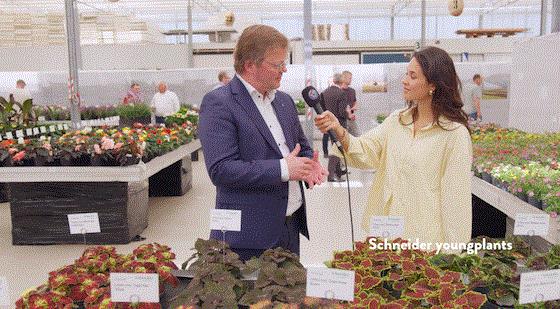
Managing director Jacob Schneider at Flower Trials.
Still, unlike Bunnik, whose owners have decided to close the business for good, Schneider indicates they want to find a way to reorganize and keep the greenhouse doors open through “potential partners” or “investors.”

A Fall first for Ball
Thank you to GrowerTalks editor Jen Zurko, who did the reporting on this item:
Ball Seed’s inaugural “Ball for Fall” event—held over two days, September 19 and October 3—brought in some 200 grower customers to see how the newest mums, pansies and other fall-themed varieties were holding up during an unseasonably warm early autumn.
It’s been ages since there’s been any formal trials event in the Midwest centered around mums (maybe Bossman Beytes can remember if there ever was one [No, I can’t—Bossman]) and that was a reason why they thought it would be a good idea. But Jaime Kedrowski, Marketing Manager for Ball Seed, said that’s not the only reason. One of the goals was to test the Ball Mums families alongside other breeder genetics under Midwest conditions, like you do with any other flowering plant trial, assessing bloom time, color and habit. Another reason was to showcase what Ball Seed has to offer their customers beyond the spring season.

“We’ve had some fantastic genetic innovation over the last couple of years across all of our breeding partners, and we’re seeing the performance through the end of the summer, being more resistant to the heat and performing through the cooler fall season,” Jaime explained. “Fall is also an opportunity for our growers to extend their season, so we wanted to highlight some of the mum varieties, but also other fall annual color that they can work into their programs.”
Added Jessie McMillin, Ball Seed’s mums product manager, “Our number one goal at the end of the day is to make sure that you have the easiest mum possible to grow—a good, reliable plant that you’re not going to have to worry about over the summertime.”

What the growers thought (Ball for Fall, continued)
Matt Foertmeyer of Foertmeyer & Sons Greenhouse drove all the way from Ohio to attend. They grow 480,000 mums, so he and his dad Mark wanted to take advantage of the chance to see a side-by-side comparison of different varieties in person.
“I asked about the transplant dates and it helps that they were all planted on the same day. And that they didn’t use PGRs, so it’s a true trial,” said Matt. “I hope they do this every year and that it keeps getting bigger.”
Mike Clesen, owner of L&M Greenhouse in nearby St. Charles, Illinois, agreed.
“I’m glad this is a natural trial and it’s a good comparison to how I grow them,” said Mike. “I always try to include new ones, so I look for specific things, like a good, tight habit, decent flower size and good color.”

When you ask growers what’s the popular color in poinsettias, you get the same answer (red). When you ask the same thing about mums, you get a bunch of different answers. They did agree that it’s different every year, but it depends on your market and on the whims of the consumer. Mike said red and yellow went first this year; last year, the first to sell out was orange.
Matt said their number one seller is the daisy type and that he hopes that there’s going to be breeding that will offer more options. “They’ve become the biggest part of this segment for us, but there aren’t enough to fill the need.”
If the Ball for Fall event wasn’t on your radar, they plan on holding another one next year around the same time, though it may only be on one day instead of two. Jaime also said that they’re going to discuss expanding the trial to include the number of mum families and more colors.

I finally arrive … a week later
Better late than never, isn’t that what they say? Because when I showed up at the Mother Ship (as we out-of-towners affectionately called Ball Hort HQ), the Ball for Fall mums were still on display, albeit just a bit more open, and so I jumped at the chance to check them out. (Actually, hortistician Dr. Marvin Miller came by my desk and said, “Let’s go look at the mums” and I said, “Sure!”)

It’s not a massive trial—just 684 pots of about 170 varieties from four breeders: Ball, Dümmen Orange, Gediflora and Syngenta. But as Jen pointed out, it was the inaugural year. Expect to see more next time. And it included some other fall flowering plants, including the new Top Wave pansies.
Mums were arranged from earliest to latest to flower, and you could see plants on the west end of the display were more bloomed out that those at the east. A few had lodged open, but overall, every variety, whether an early or late variety, still looked good on October 8. There’s been a crowd in the garden the previous two Fridays, and visitors were given flags with which to vote for their favorites. I’ll share a few of those below.
One thing I noted was that I hadn’t paid attention to the trademarked “Belgian Mums” from Gediflora in quite some time, possibly because so many mums now have that signature beachball or “European” shape of the Belgian mums.

Belgian mums, from Gediflora.
In fact, had they not been labeled by breeder, it would have been hard to pick them out. But they also tout loads of flowers and a lack of need for staking or netting … but of course that often comes down to the grower and growing conditions. Regardless, it was nice to take a look at them.

Fall mums (continued)
Being a Ball trial, Ball’s mums had the bulk of the space, and the company showed off five families that fill various needs, including two new ones, Cyclone and Axios. Ball’s mum manager Jessie McMillin describes the Cyclone family this way:
Each of the mums in this family sport vibrant colors (Golden Yellow, White, Pink, Light Pink, Yellow) and fantastic color retention that will help with overall sell-through. Plants have a medium vigor and mounded habit with a flower date of 9/26.
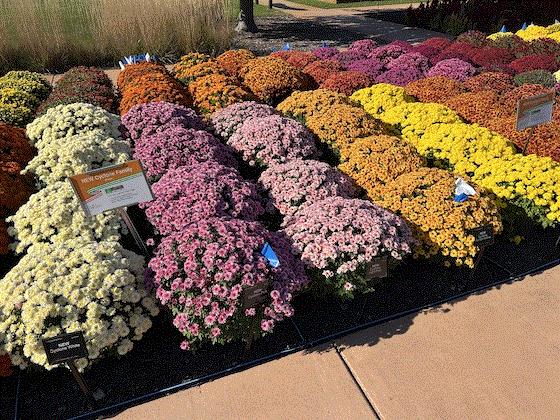
Cyclone family
And the Axios Family:
What an amazing European habit on these mums, with gorgeous color options (Pink, White, Yellow, Purple, Coral, Light Pink, Orange). Axios has a 9/24 bloom date and large/medium vigor. I expect this family to be an easy add-on to every mum grower’s program due to its uniformity, shipability and dependable habit.
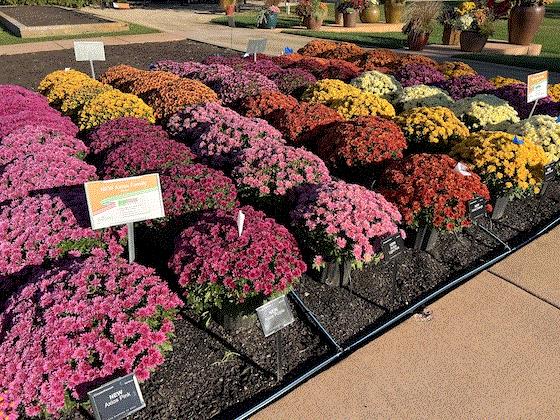
Axios family.
As for the voting, I spotted three varieties that seemed to have the most flags stuck in them:
Metrona Bronze

Spicy Pumpkin Orange
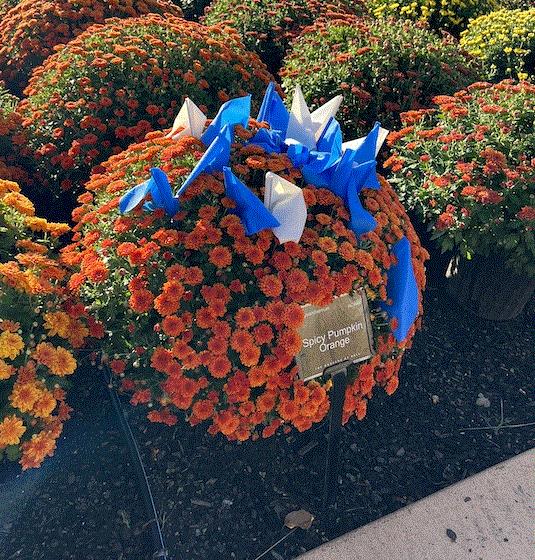
Cosmic Fireball Red
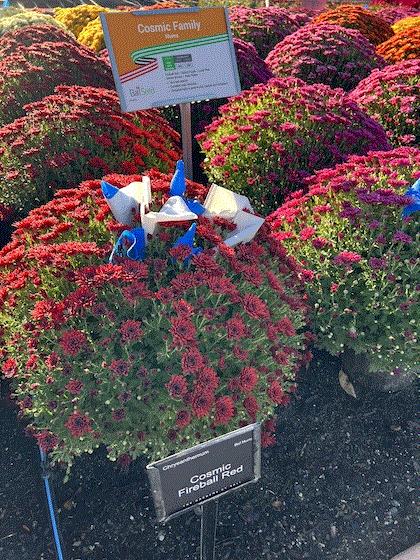
Speaking of Cosmic, Jessie says that family is her pick for the very late season. The family has that European habit that looks great in baskets or containers. Cosmic has a medium/small vigor, excellent color retention and a 10/9 bloom date. Great as a standalone or in mix containers.
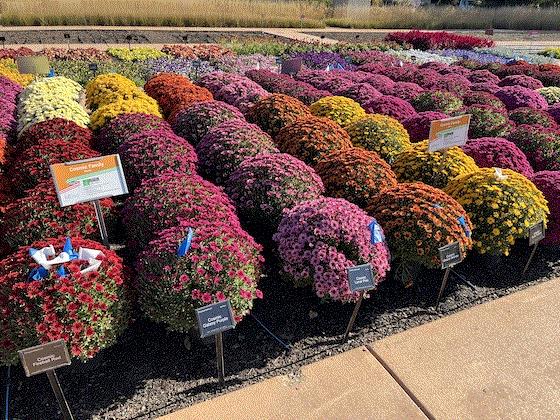
The Cosmic family.


Finally …
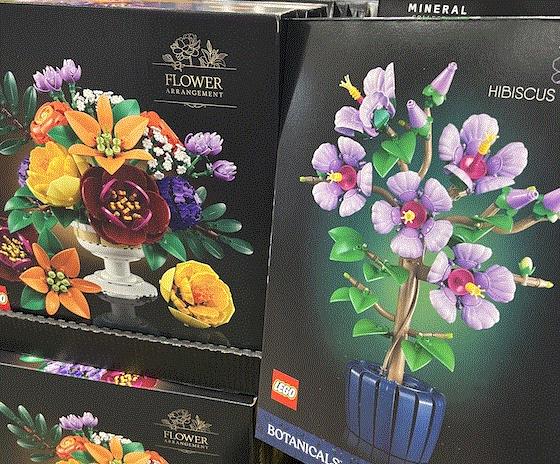
Those LEGO Botanicals (which I’ve written about before in this spot) must really be taking off, because I have spotted more for sale for Christmas at my local Costco. They are stocking four different sets: Petite Sunny Bouquet, Japanese Maple Tree, Flower Arrangement and Hibiscus. Prices range from $22 to $80.
Curious, I did a bit of research and learned that LEGO’s Botanical Collection started in 2021 with two models. Today, there are 25, so they must be growing in popularity.
Oddly, I noted that they’re labeled for ages 18+ because they’re intended to be used as display pieces, not as toys.
Well, that makes no sense to me. Don’t kids decorate their bedrooms? And unless they are somehow obscene (pistils? stamens?), the 18+ age designation is just dumb. Buy ’em for your kids!
No, wait, scratch that. Buy ’em a real flower, plant or bouquet!
Feel free to email me at beytes@growertalks.com if you have ideas, comments or questions.
See you next time!

Chris Beytes
Editor-in-Chief
GrowerTalks and Green Profit
This e-mail received by 29,728 loyal readers!
Thanks to my loyal sponsors, who help me reach the 29,728 readers of Acres Online in more than 60 countries. Want to be one of them (a sponsor, that is)? Give Kim Brown a shout and she will tell you about our many advertising opportunities.